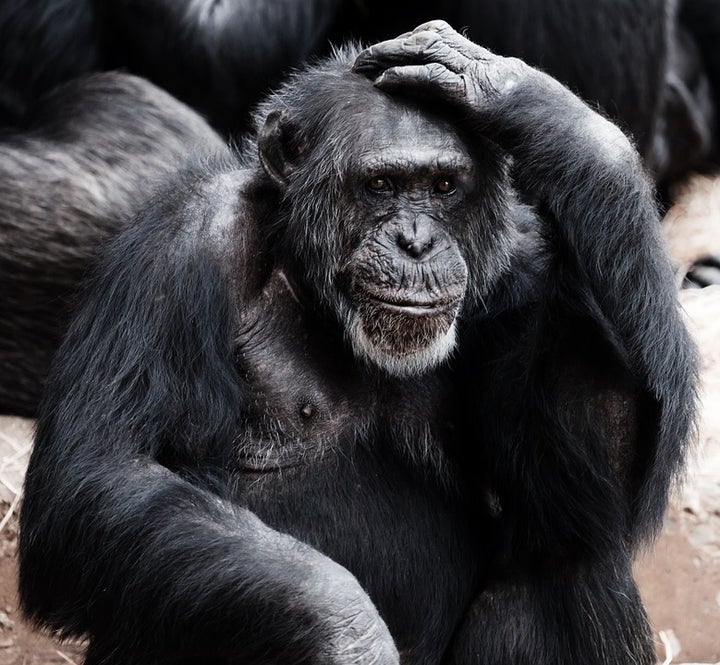
A disturbing dispute over lab chimpanzees' retirement to Chimp Haven
This is a guest essay by Dr. Barbara King. I am extremely pleased to offer this very thoughtful and important piece to you.
At Chimp Haven in Louisiana, preparations continue to make it ready for over 300 chimpanzees who gradually are being released from federal biomedical laboratories, to begin their retired lives in sanctuary. These new arrivals will join about 200 chimpanzees residents who already live at Chimp Haven.
The National Institutes of Health (NIH) announced in August that all the chimpanzees it owns will, by the year 2021, be retired to Chimp Haven, which is the national chimpanzee sanctuary as designated by the CHIMP Act (more formally, the Chimpanzee Health Improvement, Maintenance and Protection Act of 2000.)
But if the National Association for Biomedical Research had had its way, the chimpanzees would not be living out (or soon living out) their days in the 200 acres of Louisiana woodland. Instead they would have remained confined in the laboratories at places like the Keeling Center for Comparative Medicine and Research in Bastrop, Texas, and the Southwest National Primate Research Center in San Antonio, Texas, where they were used, sometimes for decades, in research experiments.
I learned about these developments earlier this month from documents sent to me by Justin Goodman, Vice-President for Advocacy and Public Policy at White Coat Waste in Washington, D.C. Goodman and I had worked together previously, when he was at PETA, on a project to stop maternal-deprivation experiments on monkeys at an NIH laboratory, so he no doubt knew I would be interested in this issue.
The documents show that earlier this year NABR Director of Public Policy Michael Dingell lobbied Congress for the chimpanzees to retire “in place”—in the labs themselves. I confirmed this fact with two congressional staffers, each from a different office on the Hill and each coming forward to me only with a guarantee of anonymity.
One staffer told me by email earlier this month, "In my capacity as a staffer responsible for animal welfare issues in a Congressional office, in June 2016 I met with Michael Dingell who was representing the National Association for Biomedical Research. During this meeting, he urged our office to oppose retiring chimpanzees to Chimp Haven and handed me a three-page document titled, 'Fact Sheet: Concerns About the Federal Chimpanzee Sanctuary -- Chimp Haven'." A second staffer, who also emailed me this month, said this: "I did meet with Michael Dingell from NABR and he requested that my boss oppose the retirement of NIH-owned chimpanzees to Chimp Haven." This meeting occurred in April 2016.
That three-page fact sheet noted by the first staffer, one of the documents Goodman sent to me, states explicitly that chimpanzees should retire in place in the labs, and further recommends that federal funding to Chimp Haven cease after the current funding levels end in 2018.
Had the NABR lobbying succeeded -- which it did not -- the chimpanzees would have faced an unnecessarily difficult future: the labs impose costs on any smart and feeling primates, much less those who may have sustained physical and emotional damage from past experimentation there.
I emailed Mike Dingell at NABR to ask why these recommendations were made, and he sent me this response, which I quote in full:
"The National Association for Biomedical Research (NABR) strongly supports the humane care and treatment of all research animals. NABR was concerned to learn that 9 out of 13 retired National Institutes of Health (NIH) chimpanzees that were in stable health prior to transfer died over a period of months at the federal sanctuary. NABR was further concerned to learn that this represents a nearly 70% mortality rate, much greater than the 4%-6% rate at medical research centers.
Considering the animals’ age, health, firmly established family-like groupings, and long-term relationships with caretakers, animal care professionals advise ‘retirement-in-place’. This would allow the chimpanzees to continue living a stable and comfortable life, receiving optimal care, and benefitting from state-of-the-art medical technology that is administered and monitored by teams of highly trained professionals.
All ‘retirement-in-place’ of these animals is closely monitored by federal laws and regulations – including the Animal Welfare Act – on a more frequent basis than the federally-supported sanctuary. Further, the U.S. Fish & Wildlife Service’s reclassification of captive chimpanzees as endangered species precludes their involvement in studies; and the termination of NIH-funded research protocols, announced in November of 2015, ensures that no chimpanzees will play a role in biomedical research.
NABR has and will continue to support federal funding of the federal sanctuary."
Dingell's statement raised further questions for me. In a new email, I asked him to tell me the source of his statements describing the status of and outcome for NIH chimpanzees sent on to Chimp Haven; to comment on the fact that his statement affirming NABR support for federal funding for Chimp Haven differs from the material that a congressional staffer says he handed out in June on the Hill; and to respond to a statement circulated in August by Chimp Haven President Cathy Willis Spraetz that directly addresses NABR's charges against the sanctuary.
In that statement, Chimp Haven's Spraetz wrote that "one might reasonably question why several of the transferred chimpanzees were placed on 'quality of life' watch prior to transfer. Or why most of the transferred chimpanzees were well beyond the median life expectancy for the species."
She's saying, in other words, that Chimp Haven has been receiving chimpanzees from the labs who are sick, and old. and I wanted to learn Dingell's response to that claim. Unfortunately, Dingell did not directly address my questions. He recommended that I look at this article in Wired and then noted that "NABR supports all current funding for Chimp Haven, including present authorized levels. As we state, federal funding for Chimp Haven has been authorized by Congress through Fiscal Year 2018."
So where does that leave us? What I know for sure-- on this all parties agree--is that NABR lobbied against chimpanzees' retirement to Chimp Haven, and for the apes' retirement within laboratory facilities.
What I believe to be clear from the fact sheet is that NABR also lobbied against continued funding of Chimp Haven beyond 2018. While.Dingell does not confirm this directly, in that last email message he sent me, he says that NABR supports current funding levels. That seems to me a notable word choice.
As someone who spent years observing and filming non-human primates in the wild and in captivity, I strongly believe that chimpanzees owned by NIH deserve retirement at Chimp Haven just as non-federally owned lab chimpanzees deserve retirement to sanctuaries across the country. “Economically and ethically, relegating chimpanzees to laboratories for the rest of their lives would have been tragic,” Goodman of White Coat Waste told me by email. “These laboratory facilities are tiny, relatively barren and don’t adequately provide for chimpanzees’ physical or psychological well-being. Additionally, according to the GAO, it also costs millions more each year to house federally-owned chimpanzees in these subpar laboratories instead of at Chimp Haven, where they live in large social groups on hundreds of acres of wooded outdoor space.”
At Chimp Haven, chimpanzees live in groups of 3 to 23 in multi-acre habitats and other spaces. By contrast, at Keeling there is a little over 1.2 acres of outdoor space (55,000 square feet); at Southwest, there are outdoor cage enclosures of 2 to 10 chimpanzees. These facts are found in a 2016 GAO report.
From all the evidence available, it is abundantly clear to me that most chimpanzees do thrive at Chimp Haven, as they learn to climb trees, make new ape friends, and roam over large outdoor habitats.
I'm startled and disturbed by the lengths some in the biomedical research community have gone to try and deprive these thinking and feeling closest living relatives of ours of the opportunity for a new life, out of the labs.
Dr. Barbara J. King is Emerita Professor of Anthropology at the College of William and Mary. Her most recent book is How Animals Grieve, and her new book Personalities on the Plate: The Lives and Minds of Animals We Eat will be published in March.
